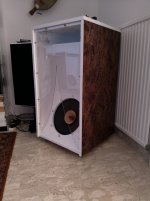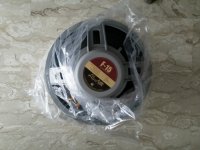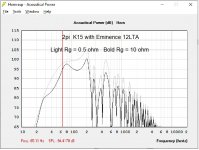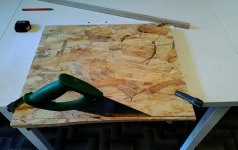I modeled the K aperture as an approximation by putting several rectangular apertures (holes) next to each other and each one different in cross sectional area following formula for K curve.
Here is the basic scheme - it's not a script and you will need to figure that out. It will take some study.

The Flute pipe thread was where I learned how to place several apertures at different locations.
http://www.diyaudio.com/forums/full-range/237384-flute-pipe-
Each aperture is nothing more than a short duct. The one duct end connects to main chamber, other is a radiator. Model a flute and you get the basics of what I am saying.
Here is the basic scheme - it's not a script and you will need to figure that out. It will take some study.
The Flute pipe thread was where I learned how to place several apertures at different locations.
http://www.diyaudio.com/forums/full-range/237384-flute-pipe-
Each aperture is nothing more than a short duct. The one duct end connects to main chamber, other is a radiator. Model a flute and you get the basics of what I am saying.
I think I got it. I started with the script in the post I quoted and adapted it. Made a spreadsheet to define ports following your formula and added 10 ports in succession. Didn't do well at all with the parameters I put into it, but that's something else. I'll look into a Klam or something like that to get me started with some viable sizes and check my model first.
I would post my script, but I was trying something out and broke it... ;-) Hit save before I knew it worked...
Thanks.
I would post my script, but I was trying something out and broke it... ;-) Hit save before I knew it worked...
Thanks.
I wonder how this K-coupler does with regards to its somewhat larger front chamber volume than usual vs having a panel like K12's above the baffle ?
- also the effects of putting the vent over the reflector?

- also the effects of putting the vent over the reflector?

Hi everyone.
I don't know if this is the main and official thread.
I have read about the karlson speaker and I would like to ask questions addressed to those who have the patience and the desire to answer.
The questions are many and I apologize for this but the desire to know is great.
To make it easier, I thought of numbering them.
1) can it be placed against the wall of the room?
2) people have written that in the low frequencies it is superior to anything else out there, but how does it cope with the medium-high frequencies?
3) How does it compare with other loads, such as bass reflex and transmission line?
4) better full range coaxial or 2-way with K-tube? I read that the K-tube reproduces a “fluid” sound but what does this word mean?
5) how do you know which speaker driver is suitable?
6) what are the downsides and trade-offs?
I would have liked to ask many other questions because there is so much curiosity but as an answer I would risk a "vaffa ..."🙂😆
bye thank you
I don't know if this is the main and official thread.
I have read about the karlson speaker and I would like to ask questions addressed to those who have the patience and the desire to answer.
The questions are many and I apologize for this but the desire to know is great.
To make it easier, I thought of numbering them.
1) can it be placed against the wall of the room?
2) people have written that in the low frequencies it is superior to anything else out there, but how does it cope with the medium-high frequencies?
3) How does it compare with other loads, such as bass reflex and transmission line?
4) better full range coaxial or 2-way with K-tube? I read that the K-tube reproduces a “fluid” sound but what does this word mean?
5) how do you know which speaker driver is suitable?
6) what are the downsides and trade-offs?
I would have liked to ask many other questions because there is so much curiosity but as an answer I would risk a "vaffa ..."🙂😆
bye thank you
Last edited:
I'll give this a shot. 🙂 I'm no authority but have dabbled with Karlsons a bit.
Perhaps, if a low-Qt driver is used in a specifically designed and tuned Karlson and the room modes are taken into account. The midbass gain with a higher Qt driver can overwhelm at times.1) can it be placed against the wall of the room?
That would be an opinion. They are a bandpass enclosure variation, of 4th, 6th or even 8th order, depending on which 'koupler'. They can be very good over 2-3 octaves, but they aren't typically made for low bass <40Hz. They can excel from 50Hz-200Hz or so. It varies with cabinet size. Approaching them with a design specific for your driver is the way to go if you want a predictable result.2) people have written that in the low frequencies it is superior to anything else out there, but how does it cope with the medium-high frequencies?
As a bandpass design, it will have gain and therefore higher efficiency than a standard reflex. The same may apply to TL, but I can't answer as confidently.3) How does it compare with other loads, such as bass reflex and transmission line?
They can be pretty blameless if operated only over their operational bandwidth. Look at my current TK6 thread to see some of the worse response issues you can come across. I still enjoyed both fullrange drivers and woofer only with K-Tube and a ~1.2kHz crossover.4) better full range coaxial or 2-way with K-tube? I read that the K-tube reproduces a “fluid” sound but what does this word mean?
The usual suspects have strong motors, so low Qt and a low Fs is a good idea for the larger Karlsons. As said above, designing for a specific driver is the way to go. Member xrk971 has an Akabak script that seems to do well. A series BP6 capable software can give a good idea of LF performance. Some of the smaller modern designs can accommodate weaker motor drivers.5) how do you know which speaker driver is suitable?
A choppy frequency response and sonic colouration. A steep LF roll-off below cutoff. A slightly more difficult build versus reflex or sealed, but nothing to be scared off, look at bass horns for that. 😉6) what are the downsides and trade-offs?
I would have liked to ask many other questions because there is so much curiosity but as an answer I would risk a "vaffa ..."🙂😆
bye thank you
IG81 answered rightfully to your many questions. We are here on a "build & try" forum of some sort and it is particularly so for the K's. I suggest you try different combinations with cheap material first, cardboard for example is the way I went and it is fun. It will give an idea of sizes corresponding to the chosen driver.Hi everyone.
I don't know if this is the main and official thread.
I have read about the karlson speaker and I would like to ask questions addressed to those who have the patience and the desire to answer.
The questions are many and I apologize for this but the desire to know is great.
To make it easier, I thought of numbering them.
1) can it be placed against the wall of the room?
2) people have written that in the low frequencies it is superior to anything else out there, but how does it cope with the medium-high frequencies?
3) How does it compare with other loads, such as bass reflex and transmission line?
4) better full range coaxial or 2-way with K-tube? I read that the K-tube reproduces a “fluid” sound but what does this word mean?
5) how do you know which speaker driver is suitable?
6) what are the downsides and trade-offs?
I would have liked to ask many other questions because there is so much curiosity but as an answer I would risk a "vaffa ..."🙂😆
bye thank you
I went with one single fullrange for many reasons, simplicity, no crossover eating up the signal, cost, a more realistic presence due to one single point of sound emission. There are always limitations, the first one being "you", the equipment would go much further than your perceptions.
I made a huge Karlsonator in OSB (crazy idea isn't it) with a LII F15 driver. For months I tried many different internal partitions, event size etc...to finally taking off the front panel so it is no more a K per say, I lose bass but gain on clarity and space, the thing is a pleasure really.
Now if I was courageous, I would try a pure original K15 design with this driver, that would help to get rid-off my wife as well....and I am not prepare yet !
Attachments
of all the defects mentioned, the coloring is what I like least of all. what causes it? is present in all karlson variants ? .A choppy frequency response and sonic colouration. A steep LF roll-off below cutoff. A slightly more difficult build versus reflex or sealed, but nothing to be scared off, look at bass horns for that. 😉
now I have to understand if woofers and tweeters I already own are suitable .
Last edited:
To me the essence of the Ks is full range or coaxial. I don't know what you mean by "coloring", every box gives color to the sound and that's the reason you have great violins or less so good. Material, thickness, size, shape, bracing, paint, joints, everything is at play.of all the defects mentioned, the coloring is what I like least of all. what causes it? is present in all karlson variants ? .
now I have to understand if woofers and tweeters I already own are suitable .
I configured a Gainclone amp for current drive some years ago, mostly to test it out and for fun. I did not have ideal speakers to use with it though. The bass-reflex impedance peaks became prominent in the frequency response and it sounded terrible. I could have stuffed the ports to ~aperiodic, but I don't think I tried that. It'll go the same for a typical Karlson. It would have to be designed for it from the get go. It would likely end-up using atypical drivers and internal configuration, but it could be accomplished. Whether it's worth doing is another matter. 🙂
the thing is a pleasure really.
My F15s be a pleasure also. OB, with helpers to make up for lack of a cabinet. The laser sharp detail in the projected scene behind the baffle plane can be scary sometimes. Do yours do that too?
Some how methinks the two pieces comprising the Karlson exponential "slot" would do well to have some sort of sound absorbtive backing - as well as the baffle the driver is set upon. (I realize that wont work if these pieces are clear plexi) But there has to be a bunch of sound pressure bouncing around in there, being as these features partially cover the driver.
Which leads me to wondering if you unwrapped the whole thing into a tall box, with the driver on top, if that "coloring" would go away?
I've only attempted to use current drive with something crossed waaay above cone resonance; a bass helped driver on an OB panel. Sounded fine to me. Just the other day I ripped it all apart, re-adusted all the filters and levels - thinking it was the cause of something amiss and it wasnt. :'(
I have no idea, it is going to be a headache for sure. I would start with a smaller back slot, the driver must be solidly fixed to the box with rather thick walls for strong rigidity with this design. It is certainly interesting to try I think, some kind of "sloted" OB, I haven't seen anyone building this design.what would it be like if it were like that?
crap or something to study?View attachment 1011067
it would be enough to apply a steel ring screwed to the two panels in order to make them become a single body
If the rear-chamber is sealed, it may make sense to build it more modularly like IG81 is experimenting with on his "TK6" geometry to get the same science-work done (and allow flexibility). I can recall Fred (or maybe xrk?) posting a hand-sketch of a dipole version years ago, but don't recall seeing this exact geometry. I think it depends what you want out of it--ie, better understanding or something closer to end-product/usable speaker. Frequency-depending cancelations moving all over the place...who knows? Displacement-limiting front-loading has its uses. That one is a rabbit hole suitable for the keen and I will cheer for anyone mad enough to do it for the sake of fun! This is the stuff that makes old people remember being young 🙂
even if I want to, I can't because I don't have the tools and skillsThat one is a rabbit hole suitable for the keen and I will cheer for anyone mad enough to do it for the sake of fun! This is the stuff that makes old people remember being young 🙂
All my DIY have been made on my kitchen table, hacksaw, files, screwdrivers, drill....basic tools and no special skills !even if I want to, I can't because I don't have the tools and skills
Attachments
Hi Freddi, it's still in use after all this time. Daughter and son-in-law use it. FWIW I build the Dutch Karlson over 50 years ago, parents had a pub on a lake site. On a quiet night, when sound would travel far, the music was clearly enjoyable several kilometers away wheras "convential boxes" with multiple drivers and crossovers would resolve in a muddled unintelligible mass. Several full range drivers mounted in a sealed box without crossover were clear too but had a narrow projection and missed the bass.I wonder how this K-coupler does with regards to its somewhat larger front chamber volume than usual vs having a panel like K12's above the baffle ?
- also the effects of putting the vent over the reflector?

HiFi? No. Enjoyable? A hell of a lot.
M.
Last edited:
- Home
- Loudspeakers
- Full Range
- Karlson




